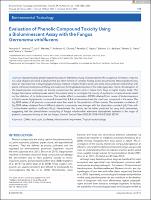Please use this identifier to cite or link to this item:
https://hdl.handle.net/20.500.12202/9622| Title: | Evaluation of phenolic compound toxicity using a bioluminescent assay with the fungus Gerronema viridilucens |
| Authors: | Ventura, Fernanda F. Mendes, Luiz F. Oliveira, Anderson G. Bazito, Reinaldo C. Bechara, Etelvino J.H. Freire, Renato S. Stevani, Cassius V. 0000-0003-1752-0726 |
| Keywords: | Tropical ecotoxicology Caffeic acid cycle Luciferase Mitochondrial impairment |
| Issue Date: | May-2020 |
| Citation: | Ventura, F. F., Mendes, L. F., Oliveira, A. G., Bazito, R. C., Bechara, E. J. H., Freire, R. S., & Stevani, C. V. (2020). Evaluation of phenolic compound toxicity using a bioluminescent assay with the fungus Gerronema viridilucens. Environmental Toxicology and Chemistry, 39(8), 1558. |
| Series/Report no.: | Environmental Toxicology and Chemistry;39(8) |
| Abstract: | Abstract:Basidiomycetes (phylum Basidiomycota) arefilamentous fungi characterized by the exogenous formation of sporeson a club-shaped cell called a basidium that are often formed on complex fruiting bodies (mushrooms). Many basidiomycetesserve an important role in recycling lignocellulosic material to higher trophic levels, and some show symbiotic relationships withplants. All known bioluminescent fungi are mushroom-forming basidiomycetes in the order Agaricales. Hence, the disruption ofthe basidiomycete community can entirely compromise the carbon cycle in nature from fungi to higher trophic levels. ThefungusGerronema viridilucenswas used in the present study to investigate the toxicity of a phenolic compound series basedon the inhibition of its bioluminescence. The median effect concentration (EC50) obtained from curves of bioluminescenceinhibition versus log [phenolic compound] showed that 2,4,6-trichlorophenol was the most toxic compound in the series. Thelog EC50 values of all phenolic compounds were then used for the prediction of their toxicity. The univariate correlation oflog EC50 values obtained from 6 different phenolic compounds was stronger with the dissociation constant (pKa) than with1-octanol/water partition coefficient (KOW). Nevertheless, the toxicity can be better predicted by using both parameters,suggesting that the phenol-driven uncoupling of fungus mitochondrial adenosine triphosphate synthesis is the origin ofphenolic compound toxicity to the test fungus.Environ Toxicol Chem2020;39:1558–1565.© 2020 SETAC |
| Description: | Scholarly article / Open access |
| URI: | https://ezproxy.yu.edu/login?url=https://search.ebscohost.com/login.aspx?direct=true&AuthType=ip,sso&db=edsgao&AN=edsgcl.630452976&site=eds-live&scope=site https://hdl.handle.net/20.500.12202/9622 |
| ISSN: | 0730-7268 |
| Appears in Collections: | Stern College for Women -- Faculty Publications |
Files in This Item:
| File | Description | Size | Format | |
|---|---|---|---|---|
| Oliveira OA Enviro Toxic and Chemistry 2020 Evaluation.pdf | 861.01 kB | Adobe PDF |  View/Open |
This item is licensed under a Creative Commons License

